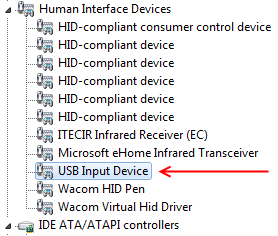Short answer: No Long answer: Yes
Short answer: No
What is this thing?
As others have already noted, it doesn't show up as a drive anywhere. But yet it's clearly doing something. Just what is this thing?
This device is what's called a USB Webkey. They are cheaply made devices that are used for marketing by some companies. They consist of a very small amount of storage with data that is loaded at manufacture, a small amount of logic and a USB connector.
Is it not a USB storage device.
How does it work?
When plugged into a computer, the device appears as though it is a keyboard. Once connected, it starts to blindly issue the keyboard strokes that are stored in the device's small amount of storage. You can cause USB Webkeys to screw up by changing the assumptions it relies on. For example, uninstalling or moving the web browser it expected to be available in a certain location or changing your keyboard layout so that the OS interprets the keystrokes differently.
So why can't I program it?
As the device appears to the computer as a simple keyboard, there is no way to override the contents of the storage by simply plugging it into a computer.
Security concerns
By plugging in a USB Webkey, you are effectively allowing the creator to do anything it wants on your computer short of anything that requires a password. A malicious creator could program it to take advantage of security holes to install malware. If a malicious creator is able to figure out the target's computer password beforehand, they could program that into the webkey and gain even more control.
But since we can't reprogram it, if we only plug in webkeys from companies we recognize we're alright, right?
Well....
Long answer: Yes
Even though you can't reprogram the device through the USB interface, the device can be reprogrammed with a little bit of sobering and low-level know-how. By disassembling the device you can gain physical access to the EEPROM chip. From there you can solder wires in to connect it to some probe hardware and start reprogramming it. Just reverse the disassembly and now you have a hacked USB Key ready to do your bidding.
Bottom Line
These things are a neat hack of the USB system. But the access they are granted to systems is potentially dangerous for users and valuable for malicious hackers who have some basic wiring skills.
Don't plug these things into your computer. Ask yourself this: Do you trust American Express or any other company with control over your computer? Even if the original creator is legit, you have no way of knowing if the device hasn't been tampered with. If you must, use a computer that you are able to wipe afterwords.



2Very cool - I'll bet the answer is yes. Do you have a picture of the card? – Jared Harley – 2010-04-17T00:50:12.133
I'll try and add one soon, I thought about it, but was too lazy when I asked the question. Just ate >.< – John Bubriski – 2010-04-17T01:04:18.330
2haha, favoriteing for picture! – marcusw – 2010-04-17T01:05:53.680
Added pictures! – John Bubriski – 2010-04-17T01:25:22.757
I'ts for their "Zinc" card. – John Bubriski – 2010-04-17T01:25:39.357
1A USB connector does not necessarily indicate presence of a drive. Are you sure it's a drive? – Ignacio Vazquez-Abrams – 2010-04-17T01:42:36.820
Nope! But there must be some sort of memory on there, right? Is it possible to reprogram it? – John Bubriski – 2010-04-17T01:43:41.407
it doesn't show up in disk management does it? I'd doubt it. xD – Vervious – 2010-04-17T03:50:28.017
No it doesn't :( – John Bubriski – 2010-04-17T15:51:20.710